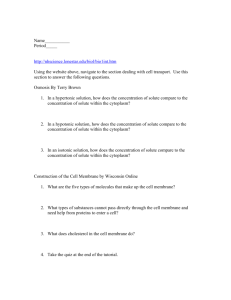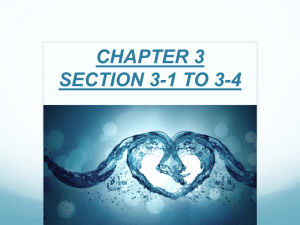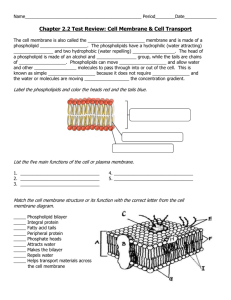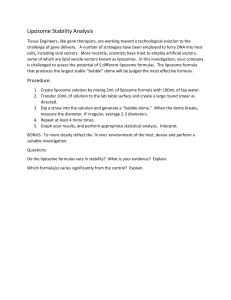Document 13605034
advertisement
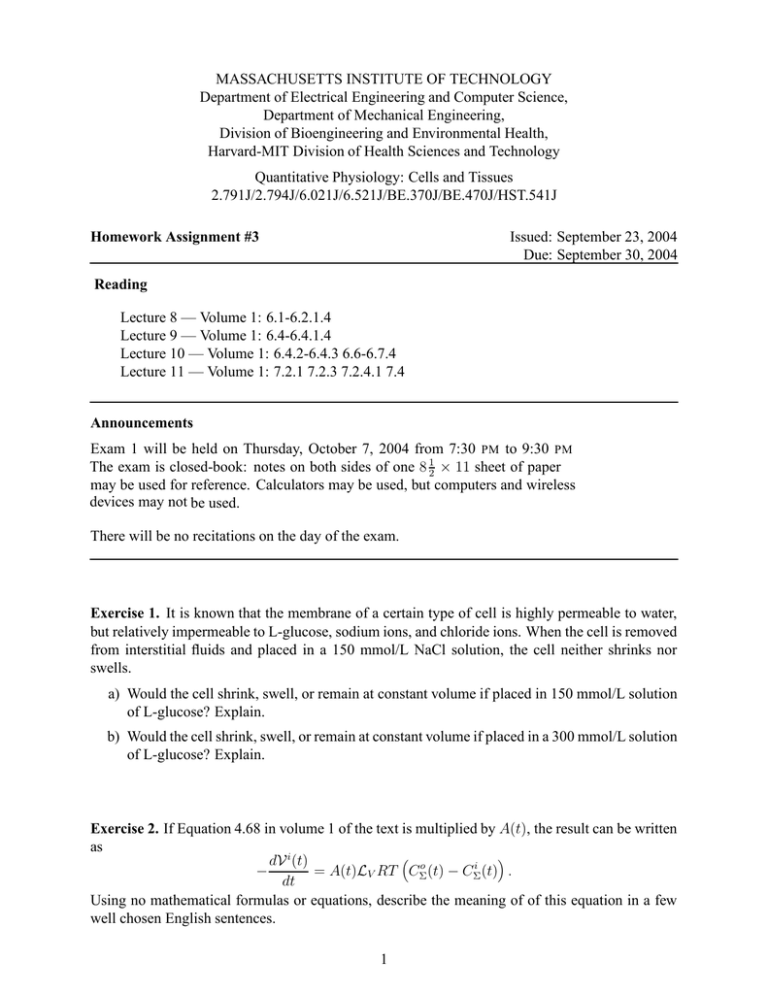
MASSACHUSETTS INSTITUTE OF TECHNOLOGY Department of Electrical Engineering and Computer Science, Department of Mechanical Engineering, Division of Bioengineering and Environmental Health, Harvard-MIT Division of Health Sciences and Technology Quantitative Physiology: Cells and Tissues 2.791J/2.794J/6.021J/6.521J/BE.370J/BE.470J/HST.541J Homework Assignment #3 Issued: September 23, 2004 Due: September 30, 2004 Reading Lecture 8 — Volume 1: 6.1-6.2.1.4 Lecture 9 — Volume 1: 6.4-6.4.1.4 Lecture 10 — Volume 1: 6.4.2-6.4.3 6.6-6.7.4 Lecture 11 — Volume 1: 7.2.1 7.2.3 7.2.4.1 7.4 Announcements Exam 1 will be held on Thursday, October 7, 2004 from 7:30 PM to 9:30 PM The exam is closed-book: notes on both sides of one 8 12 × 11 sheet of paper may be used for reference. Calculators may be used, but computers and wireless devices may not be used. There will be no recitations on the day of the exam. Exercise 1. It is known that the membrane of a certain type of cell is highly permeable to water, but relatively impermeable to L-glucose, sodium ions, and chloride ions. When the cell is removed from interstitial fluids and placed in a 150 mmol/L NaCl solution, the cell neither shrinks nor swells. a) Would the cell shrink, swell, or remain at constant volume if placed in 150 mmol/L solution of L-glucose? Explain. b) Would the cell shrink, swell, or remain at constant volume if placed in a 300 mmol/L solution of L-glucose? Explain. Exercise 2. If Equation 4.68 in volume 1 of the text is multiplied by A(t), the result can be written as � dV i (t) − = A(t)LV RT C�o (t) − C�i (t) . dt Using no mathematical formulas or equations, describe the meaning of of this equation in a few well chosen English sentences. 1 Exercise 3. The following figure shows schematic diagrams of two cells that have the same volume but quite different shapes. One cell (left panel) is spherical, the other is approximately cylindrical but contains a large number of microvilli. The cell membranes have the same hydraulic conductivity to water. If the two cells are subjected to the same decrease in extracellular osmolarity, which cell swells more rapidly? Explain. Exercise 4. Consider the simple, symmetric, four-state carrier model. For each of the following conditions, find NiE , NoE , NiES , NoES , and �S . Explain the physical significance of each of your answers. a) � = 0. b) φ = 0. c) K = 0. Exercise 5. Consider the simple, symmetric, four-state carrier model when c iS = coS = 0. Sketch the carrier density in each of its four states as a function of �/φ. Give a physical interpretation of your results. 2 Problem 1. A volume element with constant cross-sectional area A has rigid walls and is divided into two parts by a rigid, semipermeable membrane that is mounted on frictionless bearings so that the membrane is free to move in the x-direction as shown in the following figure. c1 c2 0 x 10 (cm) The semipermeable membrane is permeable to water but not to the solutes (glucose or NaCl or CaCl2 ). At t = 0, solute 1 is added to side 1 to give an initial concentration of c 1 (0) and solute 2 is added to side 2 to give an initial concentration of c2 (0). Concentrations are specified as the number of millimoles of glucose or NaCl or CaCl2 per liter of solution. The initial position of the membrane is x(0). For each of the following parts, find the final (equilibrium) values of the membrane position x(�), and the concentrations, c1 (�) and c2 (�). 2 (a.) c1glucose (0) = 0; cglucose (0) = 10; x(0) = 5. 2 (b.) c1 glucose (0) = 30; cglucose (0) = 70; x(0) = 7. 2 (c.) c1 glucose (0) = 20; cglucose (0) = 10; x(0) = 3. 2 (d.) c1 glucose (0) = 30; cN aCl (0) = 20; x(0) = 4. (e.) c1CaCl2 (0) = 20; c2N aCl (0) = 30; x(0) = 3. Problem 2. A spherical cell has a freely distensible membrane that is permeable to solute A, im­ permeant to solute B, and permeable to water. The cell contains N I moles of impermeant solutes, and is allowed to equilibrate in a bath in which the concentration of A is zero and the concentration of B is c1 . The bath is large compared to the cell. The cell volume in this bath is V 0 . At t = 0, the cell is moved to a bath that contains equal concentrations of A and B, c A = cB = 12 c1 . a. Is the new bath hyper-, hypo-, or iso-osmotic with the cell at t = 0? b. If the hydraulic conductivity of the cell is LV , what is the rate of increase of the volume, dV(t)/dt just after the cell is moved (i.e., at t = 0+ )? c. What is the equilibrium volume of the cell in terms of V0 ? Explain briefly. 3 Problem 3. The following figure shows the design of a miniature pump that can be implanted in the body to deliver a drug. No batteries are required to run this pump! Rigid, semipermeable membrane 0.7 cm Frictionless, impermeable piston Chamber 1 (solute) Drug orifice Chamber 2 (drug) 3 cm The pump contains two cylindrical chambers filled with incompressible fluids: the two chambers together have a length of 3 cm and a diameter of 0.7 cm. Chamber 1 is filled with a solution whose concentration is 10 mol/L; the osmolarity of this solution greatly exceeds that of body fluids. Chamber 2 is filled with the drug solution. The two chambers are separated by a frictionless, mass­ less, and impermeable piston. The piston moves freely and supports no difference in hydraulic pressure between the chambers; the piston allows no transport of water, solute or drug between chambers. The pump walls are rigid, impermeable and cylindrical with an orifice at one end for delivering the drug and a rigid, semipermeable membrane at the other end. The orifice diameter is sufficiently large that the hydraulic pressure drop across this orifice is negligible and sufficiently small so that the diffusion of drug through the orifice is also negligible. The semipermeable mem­ brane is permeable to water only, and not permeable to the solute. Assume that T = 300 K. a) Provide a discussion of 50 words or fewer for each of the following: i) What is the physical mechanism of drug delivery implied by the pump design? ii) What is(are) the source(s) of energy for pumping the drug? iii) Assume there is an adequate supply of drug in the pump for the lifetime of the im­ planted subject and that it is necessary to provide a constant rate of drug delivery. Which fundamental factors limit the useful lifetime of this pump in the body? b) When implanted in the body, the pump delivers the drug at a rate of 1 µL/h. Find the value of the hydraulic conductivity, LV , of the semipermeable membrane. 4 Problem 4. A large fraction of the molecules in a cell membrane are phospholipids, which have a hydrophilic head and hydrophobic tails. When purified phospholipids are added to a saline solution, the phospholipids self assemble into a variety of stable structures, one of which is spherical and is called a liposome. Liposomes have saline interiors and exteriors that are separated by a phospholipid bilayer, much like a biological cell. Liposomes Bath can be used as artificial cells to test theories about membrane transport. Assume that a liposome is created in a solution that contains 200 mmol/L of a solute I that cannot permeate the phospholipid biLiposome layer. Assume that the inner solution initially contains 200 mmol/L of solute I and the initial radius is 30µm. Assume that the thickness of the bilayer is much smaller than the diameter of the liposome. Assume that water can permeate the phospholipid bilayer, and that hydraulic pressure gradients across the bilayer can be ignored. Assume that the temperature is 300 K. Assume that the liposome is transfered at time t = 0 to a bath that contains 200 mmol/L of solute A and 100 mmol/L of solute B. The liposome initially shrinks but then swells and reaches an ultimate radius of approximately 38µm as shown in the following plots. The left plot shows the time course for the first 1000 seconds. The right plot shows just the first 100 seconds of the same data. 30 Radius (µm) Radius (µm) 40 35 30 25 29 28 0 500 0 1000 Time (seconds) 50 100 Time (seconds) Part a. Determine the asymptotic value of concentration cI (t) of solute I in the liposome as time increases, i.e., determine lim cI (t). t→∞ Provide a numerical value (or numerical expression) with units. If it is not possible to determine the concentration from the information provided, explain why. Part b. Indicate which, if either, of the solutes A and B can permeate through the artificial membrane? If it is not possible to determine this information, explain why. Part c. Determine the hydraulic conductivity LV of the artificial membrane. Provide a numerical value (or numerical expression) with units. If it is not possible to determine the hydraulic conductivity from the information provided, explain why. 5 Problem 5. A large fraction of the molecules in a cell membrane are phospholipids, which have a hydrophobic head and hydrophilic tails. When purified phospholipids are added to a saline solution, the phospholipids self assemble into a variety of stable structures, one of which is called a liposome. Bath Liposome Liposomes have saline interiors and exteriors that are separated by a phospholipid bilayer, much like a biological cell, as illustrated above. Liposomes can be used as artificial cells to test the­ ories about membrane transport. Assume that a liposome is created in a solution that contains 100 mmol/L of a solute A that cannot permeate the phospholipid bilayer. Assume that water can permeate the phospholipid bilayer, and that the liposome comes to equilibrium with a volume of 1 pL (10−12 L) of internal solution containing A with concentration 100 mmol/L. The liposome is then transferred to one of the following solutions • solution 1: 100 mmol/L of A plus 10 mmol/L of B • solution 2: 90 mmol/L of A plus 10 mmol/L of B • solution 3: 100 mmol/L of B where B is a solute that can permeate the phospholipid bilayer. Both A and B are nonelectrolytes, and the baths are large compared to the volume of the liposome. Assume that transport of water and transport of the permeant solute B are independent of each other, i.e., water transport does not effect transport of B and vice versa. (a.) Calculate the equilibrium volume of the liposome in solution 1. Discuss your result briefly. (b.) Calculate the equilibrium volume of the liposome in solution 2. Discuss your result briefly. (c.) Calculate the equilibrium volume of the liposome in solution 3. Discuss your result briefly. Problem 6. A monosaccharide, M , is known to be transported through a cell membrane by a carrier so that � � ci (t) co − � = �max K + ci (t) K + co where ci (t) is the intracellular concentration of M, co is the external concentration of M, � is the outward flux of M (mol/cm2 ·s) and �max is the maximum flux with which the carrier system is capable of transporting M . The area of the cell, A, is 10−6 cm2 , and K is 100 mmol/L. The following experiment is performed: the cell initially contains zero moles of M , and at t = 0 the cell is placed in an isotonic solution containing a concentration of M equal to c o (constant), where co � K. The internal concentration of M is found to be ci (t) = co (1 − e−t/� ), t � 0 where � = 100 s. The volume of the cell remained roughly constant at 10 −10 mL throughout the experiment. Determine �max . 6


